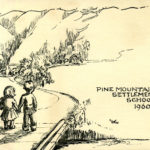Pine Mountain Settlement School
Series 24: PUBLICATIONS PMSS
CALENDARS
Guide

PMSS Calendar page for Oct-Dec, 1942. [1942_calendar_009.jpg]
TAGS: PMSS Calendars, guide to PMSS calendars, guides, print shop, John Spelman III, Arthur W. Dodd, Mary Rogers, photographs, linoleum block printing, drawings, special calendars
CALENDARS PMSS Guide
Calendars at Pine Mountain Settlement School were not published annually, yet there remains a remarkable number of calendars produced by the School and by individual workers. The following array of calendars covers a period from 1914 to the 1970s.
During the 1940s the publication of calendars was fairly regular. The work to produce the calendars was undertaken by students working in the print shop. It is this group of calendars that, arguably, provides the most interesting examples of this genre. These calendars were designed largely by two creative workers at the School: John Spelman III and Arthur W. Dodd,
The art for most of the late 1930s and 1940s calendars was created by John Spelman III who was employed during that time as the art teacher at the School. Spelman’s work reflects his deep affection for the Southern Appalachians and for the architectural forms of the mountain cabin in and around eastern Kentucky. He provided an outstanding model for the students and helped them to consider their own aesthetic responses to the region and the remarkable charm of the mountain log cabin and the basic principles of design in a two-dimensional format.
The second set of calendars during the 1940s, capturing the region in photographs, is the work of Arthur W. Dodd, school principal at the School and a skilled photographer. His work is found throughout the collections of Pine Mountian Settlement School’s photographs.
PMSS CALENDARS Guide: The Tracking of the Seasons of Time
JULIAN CALENDAR
Tracking time can be found as early as the Neolithic period of history. The first known calendars were based on the cycles of the moon. Later, primary Western calendars were based on the relationship of the earth to the sun. The Julian Calendar, named for Julius Caesar, was initiated in 46 BC and shifted away from the former lunar calendar. The Julian calendar soon became the standard adopted by western civilization and those under control of the Romans. It persisted largely because it was adopted by the later Christian church. The Julian calendar sought to simplify the complicated but accurate lunar calendar by adjustments using leap years. But, even the Julian calendar did not persist.
GREGORIAN CALENDAR
The Julian Calendar continued to perplex the timekeepers and was replaced by the Gregorian Calendar in 1582. The Gregorian calendar was named Pope Gregory XIII and was intended to refine the earlier calendar by reducing the number of leap years. The change did not happen overnight. It took some 300 years to make the adjustments. Essentially, the new calendar, like the Julian calendar, is a solar calendar with 12 months of 28–31 days each. Both calendars consists of 365 days, with a leap day being added to February in the leap years. The months and length of months in the Gregorian calendar are the same as for the Julian calendar.
While both the Julian and the Gregorian calendars based their calendars on the movement of the earth in relation to the sun, not on the cycles of the moon, they both neceded continual readjustment. Ultimately, it is the Gregorian Calendar that is in use today even though it was subsequently found that the earlier calendars, based on the lunar cycle, were only two seconds off rather than our less accurate sun calendar. Further, because it continually needed to be tweaked, the day count of the 12-month calendar was affected. Atomic clocks and other time-keepers have kept us “on time”. Buti, me still persists in “getting away from us” as in the slowing/speeding up of the earth’s rotation.,
In Appalachia, the more tangible time-keeper, the Farmer’s Almanac ,is often used to help farmers determine when to plant and when to harvest. “Planting by the moon” is still a common practice in many households.
GALLERY: PUBLICATIONS CALENDARS PMSS Guide
CALENDAR ART (A sampling)
- [Cover] 1914 Calendar. January
- “Coming to Start the School.”1914 Calendar. April
- 1938 Calendar. September
- 1940_calendar_005_mod
- 1940 Calendar. Linoleum prints by John Spelman III. September
- 1940 Calendar. Linoleum prints by John Spelman III. October
- 1941 Calendar. Drawing by John A. Spelman III. July
- 1942_calendar_007
- 1943 Calendar. 08
- Mattie Ayers in Chapel. [1944_calendar_001]
- 1945 Calendar Cover. [cale_1945_001.jpg]
- 1955 Calendar pmss_christensen_card_001
- 1951_calendar_000
- 1952_calendar_001
- 1956 Calendar. Drawings by Mary Rogers.
- 1956 Calendar Drawing by Mary Rogers.
- 1957_calendar_001
- 1958_calendar_001
- An Old Man’s Hopes, William Creech. 1959_calendar_001
- 1960_calendar_001
- 1961_calendar_001
- 1969_calendar_001
- 1971_calendar_001a
- 1972_calendar_001
- 1977_calendar_001
See Also: PUBLICATIONS PMSS Calendars
CALENDARS
1937 PMSS CALENDAR
1939 PMSS CALENDAR
1952 PMSS CALENDAR – “A Year of Song”


























